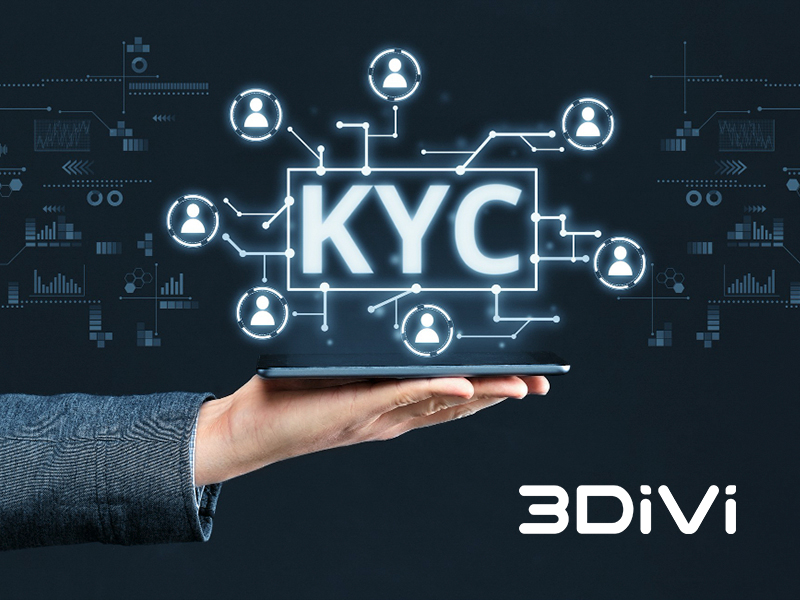Know Your Customer (KYC) plays a crucial role in combating financial crime and money laundering. Customer identification stands out as the most vital component, serving as the initial step towards enhancing performance in subsequent stages of the process.
Financial institutions face significant challenges in the global landscape of anti-money laundering (AML) and countering the financing of terrorism (CFT). They must adhere to international regulations influenced by standards such as The Financial Action Task Force (FATF), which are now incorporated into national laws. These regulations include robust directives like AML 4 and 5, along with preventive measures like client identification through "KYC."
Now, let's explore the definitions of KYC and eKYC and delve into how advanced ID verification systems can provide better support for KYC processes.
What is KYC?
KYC, or Know Your Customer, refers to the process implemented by businesses and financial institutions to verify and authenticate the identities of their customers. It involves collecting and evaluating relevant information and documents to assess the customer's identity, financial activities, and potential risks associated with their involvement in the business relationship.
The primary objective of KYC is to prevent financial crimes, such as money laundering, terrorist financing, fraud, and identity theft. By conducting thorough due diligence on customers, businesses can mitigate risks, ensure compliance with regulatory obligations, and maintain the integrity of the financial system.
The KYC process typically includes gathering essential customer information, such as their full name, date of birth, residential address, contact details, and identification documents (such as passports or driver's licenses). Additionally, it may involve assessing the customer's occupation, source of funds, and expected transactional behavior.
KYC procedures vary depending on the jurisdiction, industry, and the risk profile of the customer. They often require the establishment of robust internal controls, the use of advanced technology for identity verification, and ongoing monitoring of customer activities to detect and report suspicious transactions.
Why KYC is so important?
Banks implement KYC procedures encompassing essential measures to ensure the authenticity of their customers and assess and monitor associated risks.
These onboarding processes play a crucial role in preventing and detecting activities such as money laundering, terrorism financing, and other illicit corruption schemes.
The KYC process involves various verification methods, including ID card verification, face verification, document verification (such as utility bills as proof of address), and biometric verification.
Banks bear the responsibility of complying with KYC regulations and anti-money laundering requirements to combat fraud effectively. Non-compliance can result in severe penalties.
Over the past ten years (2008-2018), a total of USD 26 billion in fines for non-compliance with AML, KYC, and sanctions regulations have been imposed in regions such as the U.S., Europe, the Middle East, and the Asia Pacific. These fines not only carry substantial financial consequences but also cause significant reputational damage, which is challenging to measure accurately.
KYC documents
KYC checks involve relying on an independent and trustworthy source of documents, data, or information. Every client is obligated to provide credentials to verify their identity and address.
In May 2018, the U.S. Financial Crimes Enforcement Network (FinCEN) introduced a new requirement for banks. They must verify the identity of natural persons who own, control, and benefit from legal entity customers when these organizations open accounts.
In essence, when a corporate company initiates a new account, it must furnish Social Security numbers, along with copies of photo identification and passports for its employees, board members, and shareholders.
What is eKYC?
In India, Electronic Know Your Customer (eKYC) refers to a process where the customer's identity and address are electronically verified through Aadhaar authentication. Aadhaar is India's national biometric electronic identification scheme.
eKYC also encompasses the capturing of information from IDs using OCR (Optical Character Recognition) technology. It involves extracting digital data from government-issued smart IDs equipped with a chip, typically requiring a physical presence. Additionally, certified digital identities and facial recognition technologies are utilized for online identity verification in the eKYC process.
eKYC, facial recognition, and digital account opening
Facial recognition technology has unexpectedly found its way into the banking sector, offering considerable potential.
One particularly hot topic in 2021 is the integration of facial recognition in online KYC onboarding processes.
Why is this significant?
The COVID-19 pandemic has accelerated the reliance of both customers and banks on digital channels and applications.
In the United States alone, 64% of primary checking account openings occurred online in Q2 2020, compared to 36% in branch.
This shift towards digital channels is expected to continue even after the pandemic, as indicated by a recent study conducted by Visa and BAI.
Furthermore, the widespread use of mobile devices has prompted businesses to prioritize mobile-first approaches and develop seamless onboarding experiences tailored for mobile users.
During the identification process, where a selfie is taken, the software typically incorporates liveness detection features to prevent spoofing attacks using static images. Liveness detection ensures that the selfie originates from a live person.
Such KYC checks are also employed in cryptocurrency trading apps.
The outcome?
Financial institutions can invest in digital onboarding strategies that encompass video KYC (video identification) and leverage biometric technologies across online and mobile channels to align with the preferences of modern customers.
Anti-Money Laundering Directive
In Europe, the implementation of the fourth Anti-Money Laundering Directive (AMLD4) in June 2017 introduced a new set of regulations aimed at assisting financial entities in mitigating the risks associated with money laundering and the financing of terrorism.
The updated version of the fifth AML Directive (AMLD5), which came into effect on 10 January 2020, presented financial institutions with new challenges, including:
- Enhancing their understanding of customers, beneficial owners of legal entities, and their financial transactions to minimize risk.
- Strengthening Customer Due Diligence (CDD) procedures.
- Maintaining control over customer identity information and sharing relevant data with central administration.
- EU member states are required to implement the directive within a two-year timeframe.
KYC and Customer Due Diligence
The KYC policy is a mandatory framework employed by banks and financial institutions for the purpose of customer identification. Its origins can be traced back to Title III of the Patriot Act in 2001, which aimed to provide tools for preventing terrorist activities.
In order to comply with international regulations targeting money laundering and terrorist financing, robust Know Your Customer procedures must be implemented during the initial stage of establishing a business relationship with a new customer.
Banks typically structure their KYC policies around four key elements:
- Customer Policy
- Customer Identification Procedures, also known as Customer Identification Program (CIP), which involve data collection, identification, verification, and checks against politically exposed person and sanctions lists.
- Risk assessment and management, which encompass due diligence and form an integral part of the KYC process.
- Ongoing monitoring and record-keeping.
This entails verifying a customer's identity using documents such as a national ID document, utilizing a document reader and advanced document verification software.
From visual ID check to digital verification
Enhanced Due Diligence (EDD) is a KYC process that incorporates a more thorough analysis to ensure higher levels of identity assurance.
For some, EDD still predominantly involves a paper-based check, requiring the completion of KYC forms.
However, for others, it has evolved into a digital process that encompasses verifying the authenticity of identity documents and even going further to authenticate the document holder through additional biometric checks, such as facial or fingerprint recognition.
By utilizing a digital ID verification process, banks can automatically capture customer demographic data, which can then be seamlessly integrated into enterprise systems like CRM. This integration enables financial institutions to:
- Streamline the customer onboarding process.
- Conduct further due diligence and risk assessments.
- Review for Politically Exposed Persons (PEPs).
- Maintain records on transactions and information obtained through Customer Due Diligence measures.
These requirements are applicable to both new and existing customers, with the extent of implementation determined by factors such as materiality and risk assessment.
Innovative approaches in KYC verification
In November 2018, various US agencies, including the Federal Reserve, jointly issued a declaration encouraging certain banks to adopt more sophisticated approaches in identifying suspicious activities. The declaration emphasized the exploration of artificial intelligence and digital identity technologies.
Earlier that year, the European Supervisory Authorities also promoted new solutions to tackle specific compliance challenges. They advocated for a unified approach to ensure consistent standards across the European Union (EU).
These authorities envisioned the implementation of various control mechanisms, such as incorporating a computer application capable of automatically identifying and verifying individuals from digital images or video sources (facial biometrics). Additionally, they proposed the use of built-in security features capable of detecting tampered images (e.g., facial morphing) by identifying pixelation or blurring.
However, it is important to note that the use of biometrics may encounter challenges due to local or regional regulations, such as the General Data Protection Regulation (GDPR) in the EU and the California Consumer Privacy Act (CCPA) in California, among others.
Useful links on AML/KYC
- FATF recommendations 2012
- The Anti-Money Laundering Act of 2020 (FinCEN June 2021)
- Sanctions and Anti-Money Laundering Act 2018 (UK)
- KYC and eKYC in India: What is KYC as per RBI?
- RBI Allows Video-based KYC yet (Money life India January 2021)
- Video KYC for digital bank opening is growing in India (02 March 2021 - The Hindu)
- Indian telcos demand Aadhaar-based e-KYC for verification charges to be reduced (Financialexpress.com, 8 October 2020)
- Bank KYC updating: No Penalty on Indian Banks (Moneylife, March 2021)
- PPP, SMBs and the challenges of KYC (pyments.com,16 October 2020)
- KYC compliance can be a competitive advantage (cointelegraph.com, 6 October 2020)
- KYC and digital-first in banking (10 December 2021)
- More on biometrics and its contribution to identification and verification
- Facial recognition in 2021: 7 trends to watch
- Discover IdCloud KYC, Gemalto Advanced ID verification solution
























